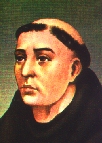Toribio de Benavente

Toribio of Benavente (1482,
Early life
Toribio entered the Franciscan Order at the age of seventeen, dropping his family name of Paredes in favor of his city of birth, as was the custom among the Franciscans.[2] In 1523, he was chosen to be among the Twelve Apostles of Mexico, to be sent to the New World.
Evangelist New Spain
This section needs additional citations for verification. (December 2021) |
After a strenuous journey he arrived in Mexico, where he was greeted with great respect by
From 1527 to 1529, he worked in
Even though Motolinía protected Indians against the abuse of Guzmán, he did not share the opinions of the
In his letter to the king, Motolinia recounts an incident of Las Casas's refusal to baptize an Indian in Tlaxcala.;
I said to Las Casas: "How is this, father, all this zeal and love that you say you have for the Indians is exhausted in loading them down and going around writing about Spaniards, and vexing the Indians, since your grace loads down more Indians than thirty (Franciscan) friars? And since you won't baptize or instruct an Indian, it would be well if you would pay those that you so load down and tire out."[3]
From 1548 to 1551 he was provincial of the Province of Santo Evangelio.
Death
Having founded many cloisters and convents in Mexico and baptized an estimated 400,000-plus Indians, he retired to the friary of San Francisco in Mexico City, where he died in 1568. He is remembered in Mexico as one of the most important evangelists.
Ethnographies
Motolinia is well known for his two histories of the
[S]ome lords and important men had... arranged to kill these children [Juan and Antonio] because they were breaking their idols and depriving them of their gods.... Antonio came out at once, and when he saw the cruelty with which these brutes were treating his servant (Juan), instead of fleeing he said to them with great spirit: "Why are you killing my companion; for it is not his fault but mine? I am the one who is taking away your idols, because I know that they are devils and not gods. If you consider them gods, take them and leave that boy alone, for he has done you no harm." Saying this he threw on the ground some idols which he was carrying in his skirt. By the time he finished speaking these words, the Indias had killed the child Juan, and then they fell upon the other, Antonio, so that they also killed him.[6]
The children had been put in the care of lords of Tlaxcala by the leader of the Twelve Apostles of Mexico, Martín de Valencia, who Motolinia thought would be especially saddened by the murders. Antonio was not just a child convert but would have become heir to a principal lord of Tlaxcala.[6]
Unlike the writings of fellow Franciscan
An English translation of significant portions of Motolinia's works was done by Elizabeth Andros Foster in 1950 for the Cortés Society and reissued in 1973 by Greenwood Press. Her introduction to the translation has a careful discussion of Motolinia's life and works.[7]
- Historia de los Indios de la Nueva España, which was not published until 1858, edited by Joaquín García Icazbalceta.
- Memoriales, first published in 1903.
- Motolinia's History of the Indians of New Spain, translated and edited by Elizabeth Andros Foster. Greenwood Press 1973.
Notes
- ^ See Thomas, Prologue, chapter 4 where he names (i) the clerics (including a Franciscan friar) who were present with Hernán Cortés in 1522; (ii) the three Flemish Franciscan lay brothers who came out in 1523 (two of whom died prematurely); and (iii) the "Twelve" (10 Franciscan priests and two Franciscan lay brothers) who came out to New Spain in 1524
References
- ^ a b c Ezquerra, Rámon. "Toribio de Benavente", Enciclopedia Franciscana
- ^ a b c Crivelli, Camillus. "Toribio de Benavente Motolinia." The Catholic Encyclopedia Vol. 10. New York: Robert Appleton Company, 1911. 12 December 2021
 This article incorporates text from this source, which is in the public domain.
This article incorporates text from this source, which is in the public domain.
- ^ Toribio de Benavente Motolinia, "The Franciscan reply (to Las Casas)" in Letters and People of the Spanish Indies, Sixteenth century, edited and translated by James Lockhart and Enrique Otte. Cambridge: Cambridge University Press 1976, p. 226. The entire letter is translated to English with an introduction, placing it in context, pp. 218-247.
- ^ Motolinia, Motolinia's History of the Indians of New Spain, pp. 37-44.
- ^ Kamen, Henry (2002). Spain's Road to Empire. Penguin Group (published 2003). pp. Chapter 3.
- ^ a b Motolinia,Motolinia's History of the Indians of New Spain, pp. 251-252.
- ^ Elizabeth Andros Foster, "Introduction" to Motolinia's History of the Indians of New Spain, Greenwood Press 1973.
![]() This article incorporates text from a publication now in the public domain: Herbermann, Charles, ed. (1913). "Toribio de Benavente Motolinia". Catholic Encyclopedia. New York: Robert Appleton Company.
This article incorporates text from a publication now in the public domain: Herbermann, Charles, ed. (1913). "Toribio de Benavente Motolinia". Catholic Encyclopedia. New York: Robert Appleton Company.
Sources
- Arjona, Doris K. (1952). "'The Twelve' Meet a Language Requirement". Hispania. 35 (3): 259–266. JSTOR 335749.
- Canedo, Lino G. (1973). "Toribio Motolinia and His Historical Writings". The Americas. 29 (3): 277–307. S2CID 147249930.
- Habig, Marion A. (1945). "The Franciscan Provinces of Spanish North America (Concluded)". The Americas. 1 (3): 330–344. JSTOR 978158.
- Thomas, Hugh (2011). The Golden Age: The Spanish Empire of Charles V. London: Penguin Books.
